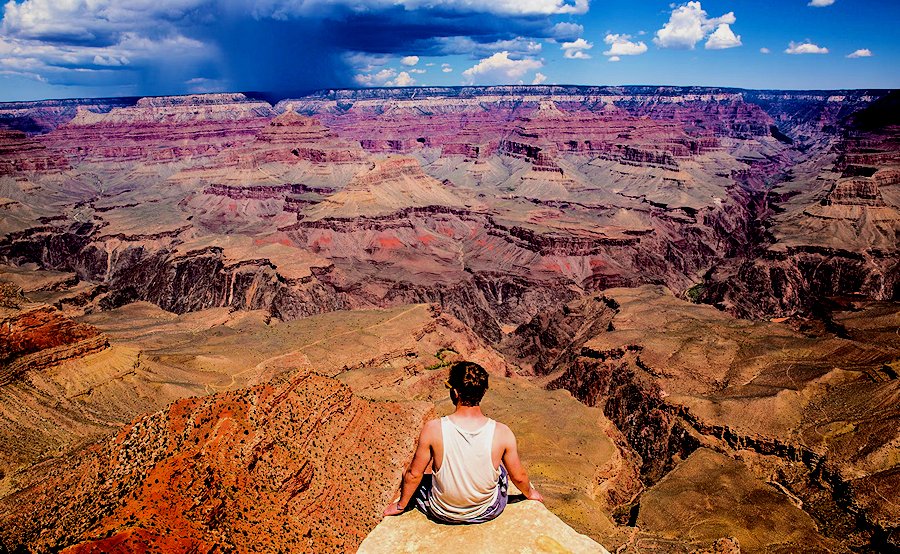Travel Notes: Destinations: North America: Arizona - Grand Canyon National Park Guide.
Short URL: https://tnot.es/GCN
Travel Guide For Visitors to Grand Canyon National Park
Known for its immense scale and stunning vistas, the Grand Canyon is a must-visit natural wonder. Consider a helicopter tour for breath-taking aerial views. Share on Facebook
Another World
Standing at the edge of Grand Canyon National Park for the first time feels like stepping into another world.
 Add a Business -
Add a Location -
Add a Lodging - Add Travel Content
- Add URL
- Travel Services.
Add a Business -
Add a Location -
Add a Lodging - Add Travel Content
- Add URL
- Travel Services.
Planning a Grand Canyon Visit
This colossal chasm, carved by the Colorado River over millions of years, stretches 277 river miles long, up to 18 miles wide, and plunges more than a mile deep.
Whether you're planning your first visit or returning to explore more of this UNESCO World Heritage Site, this comprehensive guide will help you make the most of your Arizona adventure.
Essential Grand Canyon Information
Entry Fees and Park Access
The entrance fee for Grand Canyon National Park is $35 per private vehicle.
An individual entering the park via foot, park shuttle, private rafting, bicycle or non-commercial group is $20 per person.
The motorcycle entrance fee is $30.
Admission is for 7 days and includes entrance to both the North and South Rims.
Reservations are not required to enter Grand Canyon National Park, but advance planning is highly recommended.
Consider purchasing an annual America the Beautiful National Parks Pass for $80 if you're planning to visit multiple national parks.
Senior Citizens
US citizens or permanent residents over the age of 62 can purchase an annual pass for $20 or a lifetime pass for $80, making it an excellent value for frequent visitors.
When to Visit - Seasonal Considerations
The best times to visit the Grand Canyon are March through May and September through November, when daytime temperatures are cool and crowds are thin.
These shoulder seasons offer the perfect balance of pleasant weather and manageable visitor numbers.
Spring (March-May)
The months of April and May are some of the best times to visit.
The landscape comes alive with vibrant greenery, and the mild temperatures make exploring the trails a delight.
For more manageable temperatures, March through May is the best time to visit.
This is when highs hover in the 75-90°F (23-32°C) and lows seldom dip below 50 (10°C) degrees.
Summer (June-August)
Peak season brings intense heat and massive crowds.
If you decide to visit during the summer (the park's peak season), be prepared for hordes of tourists and very limited lodging availability.
However, this is the only time the North Rim is guaranteed to be open.
Autumn (September-November)
Arguably the finest time to visit, combining excellent weather with thinning crowds as children return to school.
Winter (December-February)
The South Rim remains open year-round, offering crisp views and potential snow-dusted vistas.
The North Rim closes from mid-October through mid-May due to harsh winter conditions.
North Rim vs South Rim - Choosing Your Adventure
North Rim - The Road Less Travelled
Because only 12% of the people who visit the Grand Canyon make it to the North Rim, crowds are rarely a problem.
Due to the high elevation, temperatures peak in the 70s making it very pleasant weather.
The North Rim sits 1,000 feet higher than the South Rim, creating a markedly different ecosystem with dense forests of aspen, fir, and spruce.
North Rim Highlights
Bright Angel Point - The most accessible viewpoint with spectacular sunrise views.
Cape Royal - The southernmost viewpoint on the North Rim.
North Kaibab Trail - The only maintained trail descending into the canyon from the North Rim.
Point Imperial - The highest viewpoint in the park at 8,803 feet.
South Rim - The Classic Grand Canyon Experience
The South Rim welcomes visitors year-round and offers the most comprehensive Grand Canyon experience.
This is where you'll find the iconic viewpoints featured in countless photographs, along with the widest selection of accommodation, dining, and activity options.
Key South Rim Highlights
Bright Angel Trail - The most popular hiking trail, suitable for various fitness levels.
Desert View Drive - A 25-mile scenic drive with several spectacular overlooks.
Grand Canyon Village - Historic buildings, the Hopi House, and multiple viewpoints.
Hermit Road - Accessible by free shuttle bus (or bicycle), featuring eight viewpoints.
South Kaibab Trail - Steeper but offers better views throughout the descent.
Top Activities and Experiences
Hiking Adventures for Every Level
Challenging Adventures (Full-day or multi-day)
Bright Angel Trail to Phantom Ranch - A strenuous 9.5-mile descent requiring excellent fitness.
Rim-to-Rim Hiking - The ultimate Grand Canyon challenge, crossing from South to North Rim (or vice versa).
Easy Walks (Under 2 miles)
Bright Angel Point Trail - A short 0.5-mile walk on the North Rim with minimal elevation change.
Rim Trail - Mostly paved and relatively flat, connecting multiple viewpoints along the South Rim.
Moderate Hikes (2-6 miles)
Bright Angel Trail to 1.5 Mile Resthouse - A taste of canyon hiking with water stations and restrooms.
South Kaibab Trail to Ooh Ah Point - Excellent views without the full canyon descent commitment.
Not Hiking - Alternative Ways to Experience the Canyon
Colorado River Rafting
Experience the canyon from its depths on single-day smooth-water floats or multi-day whitewater adventures.
Helicopter and Airplane Tours
See the canyon from a bird's-eye perspective with tours departing from Grand Canyon Airport, Las Vegas, or Sedona.
Railway Journey
The Grand Canyon Railway operates vintage trains between Williams, Arizona, and Grand Canyon Village, combining nostalgia with convenience.
Scenic Drives
Take advantage of Desert View Drive on the South Rim, stopping at Lipan Point, Tusayan Museum, and Desert View Watchtower.
Accommodation Options
Gateway Communities
University town 80 miles south-east, providing the widest selection of accommodation and dining options.
Located two miles south of the park entrance, offering numerous hotels and restaurants.
Historic Route 66 town 60 miles south, known for its charming downtown and railway connection.
Inside the Park
South Rim Lodges
Bright Angel Lodge (9 North Village Loop Drive) - Historic cabins and rooms at various price points.
El Tovar Hotel (El Tovar Road 1) - The crown jewel of park lodging, offering luxury accommodations steps from the rim.
Kachina Lodge (5 North Village Loop Drive) and Thunderbird Lodge (10 Albright Street) both offer modern rooms with many offering canyon views.
Maswik Lodge (202 South Village Loop) - More affordable option located in the forest.
Tourist Map of Flagstaff
Use the Tourist Map of Flagstaff to help you decide where to stay in Flagstaff based on travel budget, preferred location, planned must-see attractions and local must-do activities.
Dining and Provisions
The park offers various dining options from casual cafeterias to upscale restaurants.
The Arizona Room at Bright Angel Lodge serves Southwestern cuisine with canyon views, whilst El Tovar Dining Room provides fine dining in an elegant atmosphere.
Stock up on supplies at the General Store in Grand Canyon Village or bring provisions from gateway communities.
Water is essential; the dry climate and elevation can lead to rapid dehydration.
Photography Tips and Best Viewpoints
Essential Viewpoints
Desert View Watchtower - Climb the 70-foot tower for 360-degree views.
Hermit's Rest - Designed by Frank Lloyd Wright protégé Mary Colter.
Mather Point - Easily accessible with ample parking and facilities.
Yavapai Point - Features the Geology Museum with canyon views through floor-to-ceiling windows.
Golden Hour Magic
The canyon transforms during sunrise and sunset when warm light illuminates the layered rock formations.
Popular sunrise spots include Hopi Point and Desert View, whilst sunset crowds gather at Hermit's Rest and Yaki Point.
Weather Considerations
Overcast days can actually provide excellent photography conditions, creating dramatic lighting and eliminating harsh shadows.
Practical Considerations
Getting There and Around
Most visitors arrive via Interstate 40 and Highway 64 from Flagstaff or Williams.
Parking can be challenging during peak season, particularly at popular viewpoints.
The free shuttle system operates year-round on the South Rim, reducing parking stress and environmental impact.
Safety Reminders
The canyon's vastness can be deceptive; what appears to be a short walk can become a dangerous situation quickly.
Stay on designated trails, carry water, and inform others of your hiking plans.
Emergency rescue from the canyon is expensive and time-consuming.
What to Pack
Arizona's high desert climate requires preparation for temperature variations.
Even in summer, temperatures can drop significantly at night.
Bring layers, a hat, sunglasses, and high-SPF sunscreen.
Comfortable walking shoes are essential, whilst proper hiking boots are necessary for below-rim adventures.
Making the Most of Your Grand Canyon Visit
Allow at least two days to truly appreciate the Grand Canyon's magnificence.
One day barely scratches the surface of this complex ecosystem and geological wonder.
Consider purchasing park guidebooks or attending ranger programmes to deepen your understanding of the canyon's natural and cultural history.
The Grand Canyon rewards those who look beyond the obvious viewpoints and venture onto lesser-known trails or participate in educational programmes.
Whether you're marvelling at your first canyon sunrise or returning to explore new areas, this natural wonder continues to inspire and humble visitors from around the world.
Remember that you're experiencing one of the world's most extraordinary landscapes; take time to put away the camera occasionally and simply absorb the overwhelming beauty and scale of this remarkable place.
More City Travel Guides
City Guides: Cities in Africa - Cities in America - Cities in Asia - Cities in Australasia - Cities in Latin America - European Cities and Regions.
More From Travel Notes
Travel Notes Online Guide to Travel
Africa - Asia - Caribbean - Europe - Middle East - North America - Oceania - South America.
The Travel Notes Online Guide to Travel helps visitors plan their trip with country and city travel guides, local tourist information, reviewed web sites, and inspiring travel content.
Travel and Tourism Guides on Travel Notes
 If you find Travel Notes useful, please take a moment to
like us on Facebook and share with your friends on social media.
If you find Travel Notes useful, please take a moment to
like us on Facebook and share with your friends on social media.
Share on Facebook
Travel Resources
.
Travel & Tourism With Industry Professionals.









